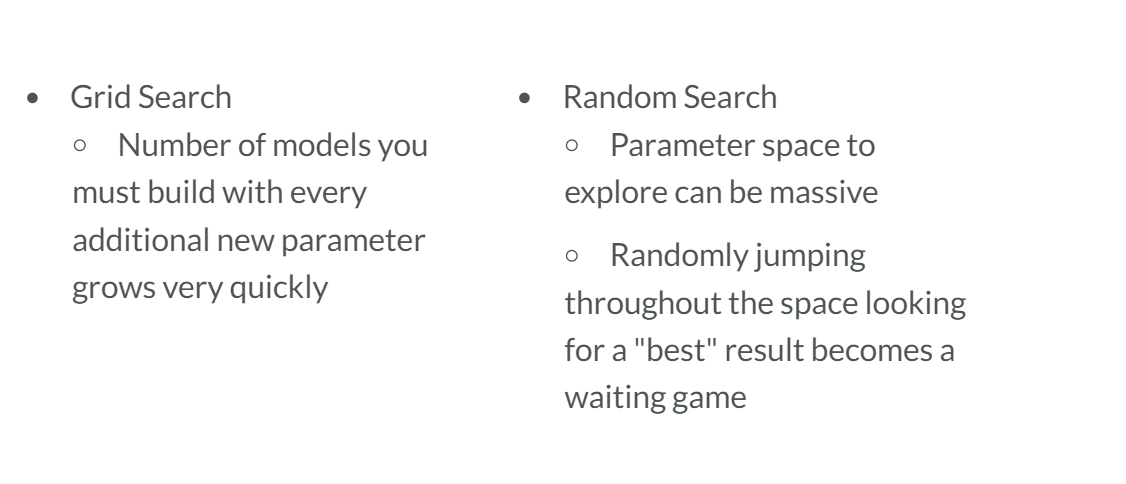Hyperparameter tuning
超参数调整
详细可以参考官方文档
定义
在拟合模型之前需要定义好的参数
适用
- Linear regression: Choosing parameters
- Ridge/lasso regression: Choosing alpha
- k-Nearest Neighbors: Choosing n_neighbors
- Parameters like alpha and k: Hyperparameters
- Hyperparameters cannot be learned by tting the model
GridsearchCV
sklearn.model_selection.GridSearchCV
- 超参数自动搜索模块
- 网格搜索+交叉验证
- 指定的参数范围内,按步长依次调整参数,利用调整的参数训练学习器,从所有的参数中找到在验证集上精度最高的参数,这其实是一个训练和比较的过程
class sklearn.model_selection.GridSearchCV(estimator, param_grid, scoring=None, n_jobs=None, iid='deprecated', refit=True, cv=None, verbose=0, pre_dispatch='2*n_jobs', error_score=nan, return_train_score=False
参数
- estimator:模型对象
- param_grid:dict or list of dictionaries,字典类型的参数,定义一个字典然后都放进去
- scoring:string, callable, list/tuple, dict or None, default: None,就是metrics,损失函数定义rmse,mse等
- Number of jobs to run in parallel. None means 1 unless in a joblib.parallel_backend context. -1 means using all processors. See Glossary for more details.控制cop,core并行运行数量
-cv:int, cross-validation generator or an iterable, optional,k折交叉验证数,默认5折- Determines the cross-validation splitting strategy. Possible inputs for cv are:
- None, to use the default 5-fold cross validation,integer, to specify the number of folds in a (Stratified)KFold,CV splitter,
- An iterable yielding (train, test) splits as arrays of indices.
- For integer/None inputs, if the estimator is a classifier and y is either binary or multiclass, StratifiedKFold is used. In all other cases, KFold is used.
- verbose:控制输出信息的详细程度,愈高输出越多。
属性
常见:
- cv_results_dict of numpy (masked) ndarrays输出交叉验证的每一个结果
- best_estimator_:最好的估计器
- best_params_:dict
- 返回最优模型参数
- Parameter setting that gave the best results on the hold out data.
- For multi-metric evaluation, this is present only if refit is specified.
- best_score_:float
- 返回最优模型参数的得分
- Mean cross-validated score of the best_estimator
- For multi-metric evaluation, this is present only if refit is specified.
- This attribute is not available if refit is a function.
复现
# Import necessary modules
from sklearn.model_selection import GridSearchCV
from sklearn.linear_model import LogisticRegression
# Setup the hyperparameter grid
# 创建一个参数集
c_space = np.logspace(-5, 8, 15)
# 这里是创建一个字典保存参数集
param_grid = {'C': c_space}
# Instantiate a logistic regression classifier: logreg
# 针对回归模型进行的超参数调整
logreg = LogisticRegression()
# Instantiate the GridSearchCV object: logreg_cv
logreg_cv = GridSearchCV(logreg, param_grid, cv=5)
# Fit it to the data
logreg_cv.fit(X,y)
# Print the tuned parameters and score
# 得到最好的模型
print("Tuned Logistic Regression Parameters: {}".format(logreg_cv.best_params_))
# 得到最好的模型的最好的结果
print("Best score is {}".format(logreg_cv.best_score_))
<script.py> output:
Tuned Logistic Regression Parameters: {'C': 3.727593720314938}
Best score is 0.7708333333333334
GridSearchCV can be computationally expensive, especially if you are searching over a large hyperparameter space and dealing with multiple hyperparameters. A solution to this is to use RandomizedSearchCV, in which not all hyperparameter values are tried out. Instead, a fixed number of hyperparameter settings is sampled from specified probability distributions.
grid相当于一个for循环,会遍历每一个参数,因此,当调参很多的时候,会导致计算量非常的大,因此,使用随机抽样的随机搜索会好一些
RandomizedSearchCV的使用方法其实是和GridSearchCV一致的,但它以随机在参数空间中采样的方式代替了GridSearchCV对于参数的网格搜索,在对于有连续变量的参数时,RandomizedSearchCV会将其当作一个分布进行采样这是网格搜索做不到的,它的搜索能力取决于设定的n_iter参数,同样的给出代码
csdn
RandomizedSearchCV
- 随机搜索法
- 不是每一个参数都被选取,而是从指定概率分布的参数中,抽取一定量的参数
我还是没太能明白?
可以比较一下时间
比较网格搜索而言,参数略有不同
算了,还是都列一下常见的吧,剩下的可以参照官方文档
比Grid 多了一个属性
- .cv_results_,可以交叉验证的每一轮的结果
复现
# Import necessary modules
from scipy.stats import randint
from sklearn.tree import DecisionTreeClassifier
from sklearn.model_selection import RandomizedSearchCV
# Setup the parameters and distributions to sample from: param_dist
# 以决策树为例,注意定一个字典的形式哦
param_dist = {"max_depth": [3, None],
"max_features": randint(1, 9),
"min_samples_leaf": randint(1, 9),
"criterion": ["gini", "entropy"]}
# Instantiate a Decision Tree classifier: tree
tree = DecisionTreeClassifier()
# Instantiate the RandomizedSearchCV object: tree_cv
tree_cv = RandomizedSearchCV(tree, param_dist, cv=5)
# Fit it to the data
tree_cv.fit(X,y)
# Print the tuned parameters and score
print("Tuned Decision Tree Parameters: {}".format(tree_cv.best_params_))
print("Best score is {}".format(tree_cv.best_score_))
<script.py> output:
Tuned Decision Tree Parameters: {'criterion': 'gini', 'max_depth': 3, 'max_features': 5, 'min_samples_leaf': 2}
Best score is 0.7395833333333334
Limits of grid search and random search
调参的限制点

- grid:
-random:
Hyperparameter tuning的更多相关文章
- 论文笔记系列-Multi-Fidelity Automatic Hyper-Parameter Tuning via Transfer Series Expansion
论文: Multi-Fidelity Automatic Hyper-Parameter Tuning via Transfer Series Expansion 我们都知道实现AutoML的基本思路 ...
- How to Evaluate Machine Learning Models, Part 4: Hyperparameter Tuning
How to Evaluate Machine Learning Models, Part 4: Hyperparameter Tuning In the realm of machine learn ...
- [C2W3] Improving Deep Neural Networks : Hyperparameter tuning, Batch Normalization and Programming Frameworks
第三周:Hyperparameter tuning, Batch Normalization and Programming Frameworks 调试处理(Tuning process) 目前为止, ...
- [C4] Andrew Ng - Improving Deep Neural Networks: Hyperparameter tuning, Regularization and Optimization
About this Course This course will teach you the "magic" of getting deep learning to work ...
- 《Improving Deep Neural Networks:Hyperparameter tuning, Regularization and Optimization》课堂笔记
Lesson 2 Improving Deep Neural Networks:Hyperparameter tuning, Regularization and Optimization 这篇文章其 ...
- Coursera Deep Learning 2 Improving Deep Neural Networks: Hyperparameter tuning, Regularization and Optimization - week3, Hyperparameter tuning, Batch Normalization and Programming Frameworks
Tuning process 下图中的需要tune的parameter的先后顺序, 红色>黄色>紫色,其他基本不会tune. 先讲到怎么选hyperparameter, 需要随机选取(sa ...
- Coursera Deep Learning 2 Improving Deep Neural Networks: Hyperparameter tuning, Regularization and Optimization - week2, Assignment(Optimization Methods)
声明:所有内容来自coursera,作为个人学习笔记记录在这里. 请不要ctrl+c/ctrl+v作业. Optimization Methods Until now, you've always u ...
- 课程二(Improving Deep Neural Networks: Hyperparameter tuning, Regularization and Optimization),第二周(Optimization algorithms) —— 2.Programming assignments:Optimization
Optimization Welcome to the optimization's programming assignment of the hyper-parameters tuning spe ...
- Coursera Deep Learning 2 Improving Deep Neural Networks: Hyperparameter tuning, Regularization and Optimization - week1, Assignment(Regularization)
声明:所有内容来自coursera,作为个人学习笔记记录在这里. Regularization Welcome to the second assignment of this week. Deep ...
随机推荐
- D语言-随机数游戏
由于不会D语言的随机数,干脆core.stdc.stdlib调用stdlib.h 这里mark一下,类型转换是cast(D语言类型) NULL不能用,要用null import std.stdio; ...
- 自定义内建模块 - Python Build Your Own Built-In Module
在 python 中, 用户可以通过 py 文件创建自定义的 module, 也可以通过 C 创建 dll, 扩展 python module. 当用户在一个正在编辑的模块 module 中, 引入( ...
- Centos 下设置静态ip地址
今天小编遇到了需要设置centos(6.4) 下静态ip地址,下面把详细步骤记录下来. 1> 首先打开这个 vi /etc/sysconfig/network-scripts/ifcfg- ...
- filebeat+kafka
kafka出现接收不到filebeat数据,最后发现版本兼容问题 filebeat换成 filebeat-7.4.2-linux-x86_64 kafka是docker-compose启动的,版本是 ...
- pretty-errors:美化python异常输出以使其清晰易读
1. 安装pretty-errors python -m pip install pretty_errors 2.如果你想让你的每一个程序都能这样在报错时也保持美貌,那么运行下面这这行命令,就不用每次 ...
- Python3标准库:pprint美观打印数据结构
1. pprint美观打印数据结构 pprint模块包含一个“美观打印机”,用于生成数据结构的一个美观的视图.格式化工具会生成数据结构的一些表示,不仅能够由解释器正确地解析,还便于人阅读.输出会尽可能 ...
- abp集成IdentityServer4和单点登录
在abp开发的系统后,需要使用这个系统作单点登录,及其他项目登录账号依靠abp开发的系统.在官方文档上只找到作为登录服务Identity Server Integration,但是host项目却无法使 ...
- clr via c# 定制特性
1,特性的应用范围:特性可应用于程序集,模块,类型,字段,方法,方法参数,方法返回值,属性,参数,泛型参数 2,利用前缀告诉编译器表明意图---下面的倾斜是必须的表明了我们的目标元素: [assemb ...
- .NetCore学习笔记:四、AutoMapper对象映射
什么是AutoMapper?AutoMapper是一个简单的小型库,用于解决一个看似复杂的问题 - 摆脱将一个对象映射到另一个对象的代码.这种类型的代码是相当沉闷和无聊的写,所以为什么不发明一个工具来 ...
- for循环嵌套练习题or99乘法表
//输出1-10之间的和 public static void whileTest(){ //定义变量用于存储不断变化的和 int sum = 0; //定义变量,用于记录不断变化的被加数 int x ...
